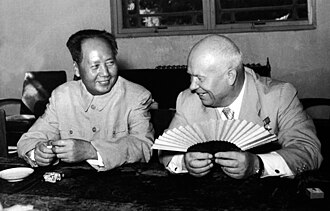WikipediaExtracts:Sino-Soviet split
Extracted from Wikipedia --
The Sino-Soviet split was the gradual worsening of relations between China and the Union of Soviet Socialist Republics (USSR) during the Cold War. This was primarily caused by divergences that arose from their different interpretations and practical applications of Marxism–Leninism, as influenced by their respective geopolitics during the Cold War of 1947–1991. In the late 1950s and early 1960s, Sino-Soviet debates about the interpretation of orthodox Marxism became specific disputes about the Soviet Union's policies of national de-Stalinization and international peaceful coexistence with the Western Bloc, which Chinese leader Mao Zedong decried as revisionism. Against that ideological background, China took a belligerent stance towards the Western world, and publicly rejected the Soviet Union's policy of peaceful coexistence between the Western Bloc and Eastern Bloc. In addition, Beijing resented the Soviet Union's growing ties with India due to factors such as the Sino-Indian border dispute, while Moscow feared that Mao was unconcerned about the drastic consequences of nuclear warfare.
In 1956, Soviet leader Nikita Khrushchev denounced Joseph Stalin and Stalinism in the speech "On the Cult of Personality and Its Consequences" and began the de-Stalinization of the USSR. Mao and the Chinese leadership were appalled as the PRC and the USSR progressively diverged in their interpretations and applications of Leninist theory. By 1961, their intractable ideological differences provoked the PRC's formal denunciation of Soviet communism as the work of "revisionist traitors" in the USSR. The PRC also declared the Soviet Union social imperialist. For Eastern Bloc countries, the Sino-Soviet split was a question of who would lead the revolution for world communism, and to whom (China or the USSR) the vanguard parties of the world would turn for political advice, financial aid, and military assistance. In that vein, both countries competed for the leadership of world communism through the vanguard parties native to the countries in their spheres of influence. The conflict culminated after the Zhenbao Island Incident in 1969, when the Soviet Union reportedly considered the possibility of launching a large-scale nuclear strike against China, and the Chinese leadership, including Mao, was evacuated from Beijing, before both sides eventually returned to diplomatic negotiations.
In the Western world, the Sino-Soviet split transformed the bi-polar cold war into a tri-polar cold war. The rivalry facilitated Mao's realization of Sino-American rapprochement with the US president Richard Nixon's visit to China in 1972. In the West, the policies of triangular diplomacy and linkage emerged. Like the Tito–Stalin split, the occurrence of the Sino-Soviet split also weakened the concept of monolithic communism, the Western perception that the communist nations were collectively united and would not have significant ideological clashes. However, the USSR and China both continued to cooperate with North Vietnam during the Vietnam War into the 1970s, despite rivalry elsewhere. Historically, the Sino-Soviet split facilitated the Marxist–Leninist Realpolitik with which Mao established the tri-polar geopolitics (PRC–USA–USSR) of the late-period Cold War (1956–1991) to create an anti-Soviet front, which Maoists connected to the Three Worlds Theory. According to Lüthi, there is "no documentary evidence that the Chinese or the Soviets thought about their relationship within a triangular framework during the period."
